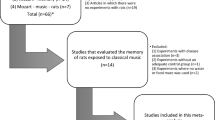Summary
Sixteen rats of both sexes of a strain selectively bred for high performance levels in an aversive learning task, were examined for differences in rearing frequency and escape/avoidance performance under various doses of the drugs reserpine and prenylamine. At the highest dosages employed 4.0 mg/kg of reserpine and 40.0 mg/kg of prenylamine, activity and conditioned avoidance performance was depressed. These findings seem to suggest that the depletion of the catecholamine levels of the organism may be responsible for these effects and that disruption of aversive learning is due to the action of the drugs in depressing activity, rather than some more direct action on the learning process itself.
Similar content being viewed by others
References
Baumgarten, A.: The clinical effects of a new anti-anginal agent, Prenylamine (Segontin). Med. J. Aust. 49, 429–431 (1962).
Broadhurst, P. L., and G. Bignami: Correlative effects of psychogenetic selection: a study of the Roman High and Low Avoidance strains of rats. Behav. res. Ther. 2, 273–280 (1965).
Carlsson, A.: Drugs which block the storage of 5-hydroxytryptamine and related amines. In: Handbuch der exp. Pharmak., Ergänzungswerk, Bd. 19. Ed. by V. Erspamer. Berlin-Heidelberg-New York: Springer 1965.
Clymer, N. V., and J. Sieftter: A method of screening sympathomimetic amines for stimulant action on the cerebrum. J. Pharmacol. exp. Ther. 89, 149–152 (1947).
Hanson, C. F.: The disruption of conditioned avoidance responses following selective depletion of brain catecholamines. Psychopharmacologia (Berl.) 8, 100 to 110 (1965).
Holland, H. C., and B. D. Gupta: Some correlative measures of activity and reactivity in two strains of rats selectively bred for differences in the acquisition of a conditioned avoidance response. Anim. Behav. 14, 574–580 (1966 a).
— —: The effect of difference doses of methylpentynol on escape/avoidance conditioning in two strains of rats selectively bred for high and low emotionality. Psychopharmacologia (Berl.) 9, 419–425 (1966 b).
— —, and E. Weldon: A note on rearing and an environmental restraint. Aktiv. nerv. sup. (Praha) 8, 140–144 (1966).
Levine. S., and S. J. England: Temporal factors in avoidance learning. J. comp. Physiol. Psychol. 53, 282–283 (1960).
McKenna, B. R.: Uptake of catecholamines by the hearts of rabbits treated with Segontin. Acta physiol. scand. 63, 413–422 (1965).
Obianwi, H. O.: The effect of prenylamine (Segontin) on the amine levels of brain, heart and adrenal medulla in rats. Acta pharmacol. (Kbh.) 23, 383–390 (1965).
Ray, O. S.: The effects of tranquillizers on positively and negatively motivated behavious in rats. Psychopharmacologia (Berl.) 4, 326–342 (1963).
Schöne, H. H., and E. Lindner: Die Wirkung des N-3′-phenyl-propyl (2)-1, 1-diphenyl-propyl-(3)-amins auf den Stoffwechsel von Serotonin und Noradrenalin. Arzneimittel-Forsch. 10, 42–52 (1960).
Author information
Authors and Affiliations
Rights and permissions
About this article
Cite this article
Gregory, K. The action of the drug prenylamine (Segontin) on exploratory activity and aversive learning in a selected strain of rats. Psychopharmacologia 13, 22–28 (1968). https://doi.org/10.1007/BF00401615
Received:
Revised:
Issue Date:
DOI: https://doi.org/10.1007/BF00401615




